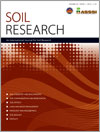SR11137 Prediction of the CEC to clay ratio using mid-infrared spectroscopy
A cheaper and faster method is needed to determine soil mineralogy. The traditional methods include X-ray diffraction, and a laboratory determined ratio of negative charge per unit weight of clay. In this paper, mid-infrared spectroscopy was used to predict this ratio, providing a cheaper and faster alternative to traditional methods.




